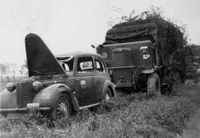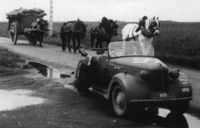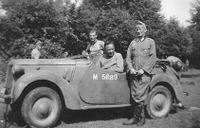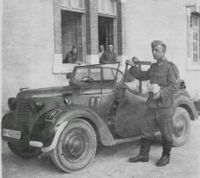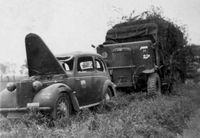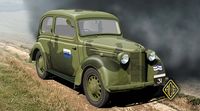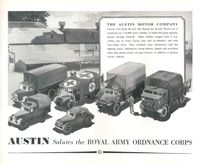Austin 8 military history
Published with thanks to and permission of the Tilly Register and Austin 8AP military register, John Simpson & Michael Schackleton
Some images are published in the book: British Military Trucks in Wehrmacht Service by Jochen Vollert and were published on this web page with permission of Tangograd Publishing.
At the outbreak of the Second World War, all types of British military vehicles were in short supply. Many private and commercial vehicles had to be impressed into military service. In fact, in the first year of the war there were more impressed vehicles in military service than custom designed examples.
The first phase of customizing vehicles was to adapt civilian and commercial designs for military use. Along with the four light and six light utilities from Austin, Hillman, Morris and Standard, the Austin 8 Tourer was an early example of this practice, although in the latter case the adaptations were few.
At the opening of the Berlin Motor Show on 17 February 1939, the Austin stand was minus any example of the Eight. The visiting German Chancellor, one Adolf Hitler, viewed the Austin stand and asked, “what have you done with the Seven?” Hitler’s first car had apparently been an early example of the Austin Seven. On the release date for the Eight, 24 February, three examples were placed on display.
The Austin Seven open tourer was acquired by the British Army in small batches throughout the 1930s. Based on the overall success of the seventeen-year history of the Austin Seven, the pioneer of this classic design, Lord (Herbert) Austin announced the launch of its successor, the Austin Eight in February 1939. Leonard Lord had been brought in as works manager from rivals Morris to turn around Austin’s fortunes and take charge of this and other new model launches.
The Eight was to be produced as a two- and four-door saloon, tourer and light van. At the opening of the Berlin Motor Show on 17 February 1939, the Austin stand was minus any example of the Eight. The visiting German Chancellor, one Adolf Hitler, viewed the Austin stand and asked, “what have you done with the Seven?” Hitler’s first car had apparently been an early example of the Austin Seven, most probably it was a BMW Dixi, which was manufactured with licence of The Austin Motor Company. On the release date for the Eight, 24 February 1939, three examples were placed on display.
The Tourer was produced in two-seat and four-seat configurations, costing £132.10s and £135, respectively. As early as April 1939, the first contract for the Military Tourer was made, albeit only for a single vehicle. Interestingly this contract, DDS 1238, was not just for a single Austin, but also an equivalent from Morris. The purchase price for the Austin was for £132.10s and its recipient was for the commanding officer of MEE. Our sources tell us this may have been the Mechanisation Experimental Establishment in Australia.
Once WD contracts were placed for multiple vehicles, the purchase price dropped. Contract V3621 shows this figure to be £122. The first proper contract was dated 16 September 1939 and identified as V3621 for 2,800 vehicles. Five further contracts followed concluding with V3996 for 148 vehicles, dated 19 June 1940. See separate section below for WD contracts in full. No further tourers and two door four light saloons would be produced for the civilian sector either, despite the four door six light saloon and delivery van going back into production after the war.
Therefore, even before the Battle of Britain commenced, the Military Tourer was no longer being made. Around 9,500 cars were produced for light communication and liaison work (the exact number varies from source to source). In most cases, they were supplied to the Royal Army Service Corps. The other initial recipient was the Royal Army Ordnance Corps. The cars were usually driven in convoy by ATS ladies from the Longbridge factory directly to their units or, if not needed urgently, to RASC Receiving Depots or RAOC Vehicle Reserve Depots.
Amongst many vehicle types delivered by ATS drivers, and other army circles, the Tourers tended to be disrespectfully referred to as ‘fleas’. Once received, the ATS would be responsible for all aspects of vehicle maintenance and preparation prior to being delivered to their receiving units. This could also include painting in camouflage and markings. We have little detail on record of those receiving units. We do know that all manner of recipients would have been allocated them as diverse as the 2 I/C of 117th Field Regiment of the Royal Artillery, the 1st Battalion of the Northumberland Fusiliers, and the Home Guard. In the latter case, the Home Guard would have received the Eight in the mid- to late-war years owing to, by then, its perceived obsolescence.
The Home Guard was well accustomed to using older and experimental equipment rejected by the regular army. We also know from photographs that the Tourer served in North Africa and in Malta painted in the distinctive stone wall camouflage. Strangely, we seem to know more about the Tourer in captured use thanks to several photographs of German units at the wheel, presumably captured in France and Belgium including the withdrawal from Dunkirk. These included the 227th Infantry Division, 162nd Infantry Regiment of the 61st Infantry Division, 1st Panzer Division, Engineer Battalion 18 and the Luftwaffe. One such example with snow chains on its rear wheels suggests it might have served on the Eastern Front according to the photograph caption. By comparison, the Tilly Register archive has relatively few confirmed photographs of the four light utilities in enemy hands, although they certainly were used as such.
The Military Tourer differed in subtle ways to its civilian cousin. The fold-down windscreen was, however, present on both civilian and military variants. The most notable change for the Military Tourer were the engine compartment side vents. There were two vertical gill-like vents on the 8AP, the Austin Tilly had three similar vents, whilst a horizontal trim was present on the civilian version. Other military features included the khaki canvas hood in place of the black ‘leatherette‘ civilian version. All Military Tourers were two-seaters, utilising the rear luggage carrying space to better effect. Those of you that have seen the classic Dad’s Army episode ‘The Making of Private Pike’, will remember this was clearly a four-seat example. This particular vehicle is a genuine military one, obviously given its rear seat after entering civilian life. The same vehicle appeared in The Eagle Has Landed. The larger civilian headlamps were retained, like the early Austin Tillys.
Notably, unlike the four Tillys, the Austin 8AP’s electrics are 6-volt. As with the Tilly, but more so, the Jeep took over the Tourer’s duties as they became available. After military service, many Tourers were offered to invalided ex-army personnel re-entering civilian life. There are around 65 known survivors of the military 8AP Tourer world wide. They are relatively well represented in museums in England. About 25 are genuine and in running condition, others are still used in civilian trim, sometimes restored with many non original parts, since genuine parts are scarce. Other cars are waiting for restoration or even beond repair unfortunately. The Austin 8AP military tourers are heavily searched for by military enthusiasts, but be aware of replica's which started their lives as civilian tourers and are now sold as genuine military cars.
This is the genuine Austin 8 AP military tourer which is part of the Austin 8 car collection of the Austin 8 register.
German captured Austin Eights
As mentioned above, the Battle of Dunkirk was fought around the French port of Dunkirk during the Second World War, between the Allies and Nazi Germany. As the Allies were losing the Battle of France on the Western Front, the Battle of Dunkirk was the defense and evacuation of British and other Allied forces to Britain from 26 May to 4 June 1940.
During this battle multiple Austin Eights were distroyed or left behind. The German troops captured the cars left behind as "beutewagen".
Hence you will find multiple images of German soldiers using the Austin 8 military cars.
Here you will find a selection of images of these Austins in German use.
Austin 8 military saloons
For a long period of time it was unclear if the Austin 8 saloons were delivered under war contract and used being army cars during WWII. In 2016 I acquired a January 1940 spare parts booklet, where on the cover, the book is referring to Austin 8 Saloon Cars impressed by the war department.
In the booklet a treasure is published. It is mentioned that an amount of 1127 two door four light saloons type ARA and 758 four door six light saloons type AR are delivered to the war department. The booklet contains all chassis numbers of the in total 1.885 cars together with the equivalent engine numbers. The chassis mentioned start with 16.236 up to 24.079, only a few mentioned have a lower chassis number. From now we are sure that 1885 Austin 8 saloons were delivered to the war department and we even know which chassis numbers and which equivalent engines were part of it. The booklet containing this details is treasured in the Austin 8 register archives.
As far as I can see at first sight the cars are manufactured same as the civilian models. Open wheels, standard hub cabs, standard pre-war air filters, same side bonnet panels etc. I have not found any specific parts for the war department cars onther than the ignition switch does not contain an ignition key.
If you wish to know if your car was a military saloon. Please feel free to contact the Austin Eight Register and I will check for you. So far only one official Austin 8 saloon survivor is known delivered under war contract.
Austin 8AP military tourer contrcats
1 Contract DDS 1238 of 19/4/39. One Austin and one Morris Tourer for MEE. Price for Austin £132.10s. WD numbers M3912449 (Austin),
3912450 (Morris). Understood to be trials vehicles.
2 Contract number unknown, of 3/9/39. Two Austins purchased in Columbo, Ceylon (now Sri Lanka). M4481760–4481770
3 Contract 294/V3621 of 16/9/39. 2,800 vehicles – 1,400 for ROAC @ £122 ex-works. 1,400 for RASC. The first half of the contract seems
to have all been fulfilled and allocated M140001–4101400, but the second figure should possibly read 1401400. (The REME Museum quotes this series as M4100001– 4101400.) The second half has 1,386 numbers allocated, but 311 of these may have been cancelled.
4 Contract 294A/502 of 14/10/39. 80 vehicles for RASC. M3918191–3918270. Chassis number sequence AP21875–25167 from spares
book.
5 Contract V3744 of 29/11/39. 1,840 vehicles for RASC. WD number sequences are fragmented and could total 2,025 vehicles in all. A typical batch runs from M212008 – 212841. Chassis number sequence AP
31914–37806 from spares book. Not every chassis number in this sequence (5893 vehicles) is present, and lines up with the 1,840 from the WD contract.
6 Contract V3794 of 1/02/40. 1,200 vehicles for RASC. Again fragmented WD batch numbers, typical being M190977–191630. These numbers allocated. Total 1,018 vehicles. Contemporary spares book lists complete
range of 1,200 chassis numbers from AP36373-40181.
7 Contract V3927 of 25/5/40. 3,467 vehicles for RASC @ £126.10s
ex-works to Olympia. Again fragmented batches totalling 3,113 vehicles, typical being M221432–222041.
8 Contract V3996 of 19/6/40. 148 vehicles for RASC. M1135165–1135312
Austin 8 AR / ARA military saloon contract
in total 1.885 Austin 8 saloons were delivered under war contract. 1127 type ARA two door four light saloons and 758 type AR four door six light wer officially delivered to the war department. All chassis numbers with equivalent engine numbers are known with the register. The chassis sequence starts with chassis 16.236 up to 24.079. Only a few mentioned have a lower chassis number.
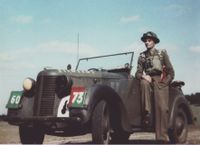
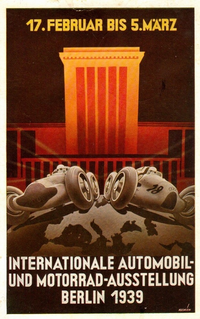
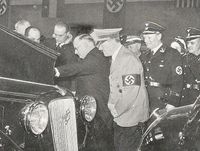
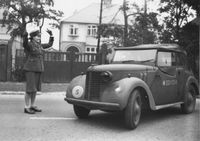



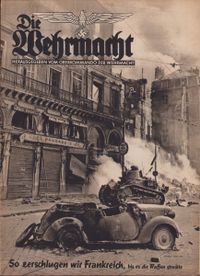
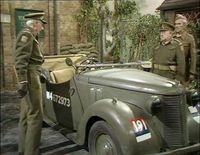

.jpg/picture-200?_=1892c56b7e0)
